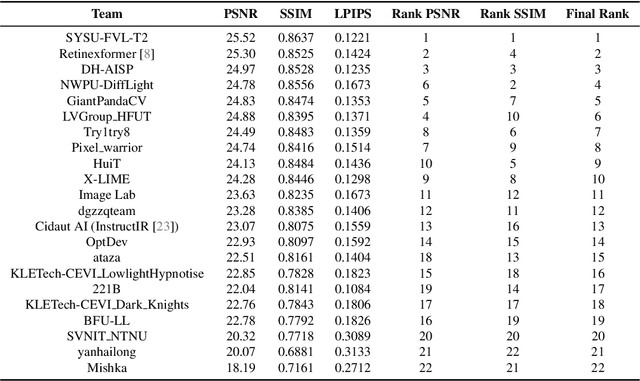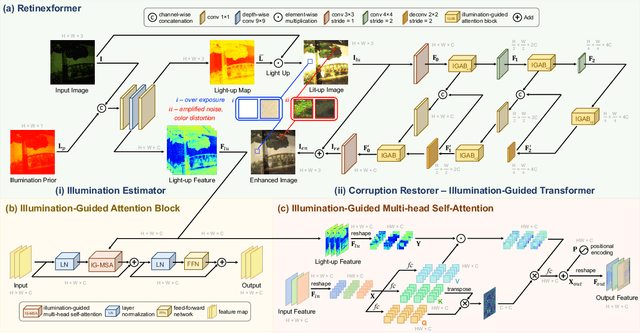Yixu Feng
HVI: A New Color Space for Low-light Image Enhancement
Feb 28, 2025



Abstract:Low-Light Image Enhancement (LLIE) is a crucial computer vision task that aims to restore detailed visual information from corrupted low-light images. Many existing LLIE methods are based on standard RGB (sRGB) space, which often produce color bias and brightness artifacts due to inherent high color sensitivity in sRGB. While converting the images using Hue, Saturation and Value (HSV) color space helps resolve the brightness issue, it introduces significant red and black noise artifacts. To address this issue, we propose a new color space for LLIE, namely Horizontal/Vertical-Intensity (HVI), defined by polarized HS maps and learnable intensity. The former enforces small distances for red coordinates to remove the red artifacts, while the latter compresses the low-light regions to remove the black artifacts. To fully leverage the chromatic and intensity information, a novel Color and Intensity Decoupling Network (CIDNet) is further introduced to learn accurate photometric mapping function under different lighting conditions in the HVI space. Comprehensive results from benchmark and ablation experiments show that the proposed HVI color space with CIDNet outperforms the state-of-the-art methods on 10 datasets. The code is available at https://github.com/Fediory/HVI-CIDNet.
NTIRE 2024 Challenge on Low Light Image Enhancement: Methods and Results
Apr 22, 2024



Abstract:This paper reviews the NTIRE 2024 low light image enhancement challenge, highlighting the proposed solutions and results. The aim of this challenge is to discover an effective network design or solution capable of generating brighter, clearer, and visually appealing results when dealing with a variety of conditions, including ultra-high resolution (4K and beyond), non-uniform illumination, backlighting, extreme darkness, and night scenes. A notable total of 428 participants registered for the challenge, with 22 teams ultimately making valid submissions. This paper meticulously evaluates the state-of-the-art advancements in enhancing low-light images, reflecting the significant progress and creativity in this field.
You Only Need One Color Space: An Efficient Network for Low-light Image Enhancement
Feb 08, 2024



Abstract:Low-Light Image Enhancement (LLIE) task tends to restore the details and visual information from corrupted low-light images. Most existing methods learn the mapping function between low/normal-light images by Deep Neural Networks (DNNs) on sRGB and HSV color space. Nevertheless, enhancement involves amplifying image signals, and applying these color spaces to low-light images with a low signal-to-noise ratio can introduce sensitivity and instability into the enhancement process. Consequently, this results in the presence of color artifacts and brightness artifacts in the enhanced images. To alleviate this problem, we propose a novel trainable color space, named Horizontal/Vertical-Intensity (HVI). It not only decouples brightness and color from RGB channels to mitigate the instability during enhancement but also adapts to low-light images in different illumination ranges due to the trainable parameters. Further, we design a novel Color and Intensity Decoupling Network (CIDNet) with two branches dedicated to processing the decoupled image brightness and color in the HVI space. Within CIDNet, we introduce the Lightweight Cross-Attention (LCA) module to facilitate interaction between image structure and content information in both branches, while also suppressing noise in low-light images. Finally, we conducted 22 quantitative and qualitative experiments to show that the proposed CIDNet outperforms the state-of-the-art methods on 11 datasets. The code will be available at https://github.com/Fediory/HVI-CIDNet.
 Add to Chrome
Add to Chrome Add to Firefox
Add to Firefox Add to Edge
Add to Edge